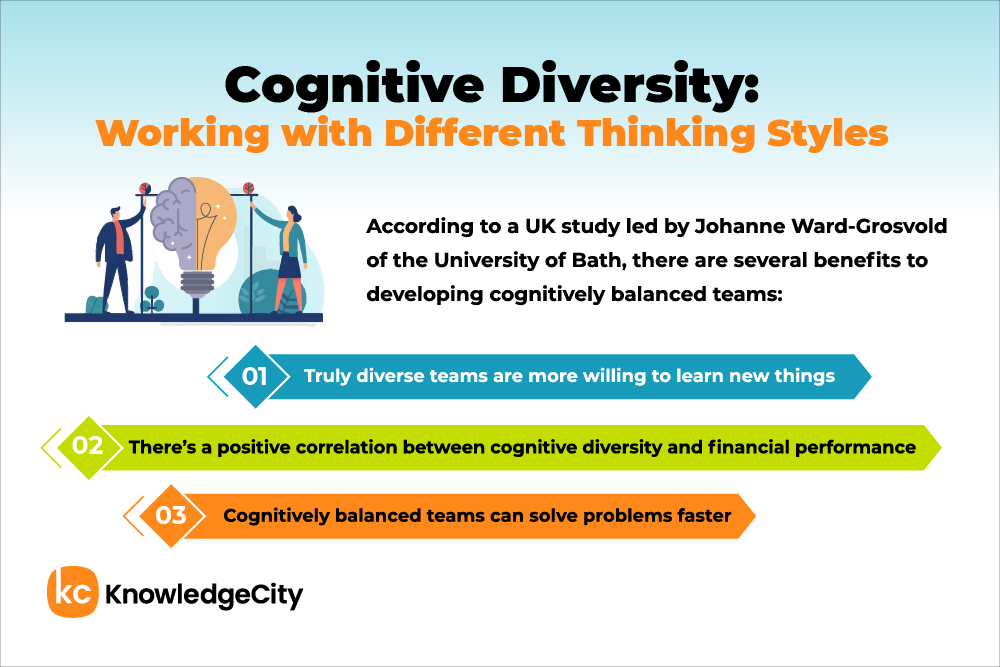Diversity refers to hiring and developing employees of different backgrounds and identities. But it’s possible to achieve a greater type of diversity, one that can bring about various benefits for teams, like improved financial performance, faster problem-solving, and reduced bias. To create a truly diverse team that fosters these benefits, managers must harness cognitive diversity, where diverse thinking styles thrive.
Let’s take a deep dive into cognitive diversity, why it’s important, and how to work with different thinking styles in your organization.

What Is Cognitive Diversity?
Cognitive diversity involves including people who think differently, solve problems using different techniques, and bring a unique perspective to their team. This form of diversity bypasses surface-level characteristics like race and age and focuses on what’s beneath the surface.
Business leaders often focus on hiring like-minded individuals who they believe may work well together as part of an agreeable team. However, this creates an atmosphere conducive to groupthink, where team meetings and collaborations result in agreements without thoroughly examining all possible solutions and vetting all ideas.
Groupthink can be harmful. If an organization is experiencing an issue, employees won’t be as likely to hear unique solutions. Groupthink is more common if there’s a homogenous working culture, where everyone tends to think and solve problems similarly.
Cognitive diversity avoids these pitfalls, spawning disagreements that spark informed decision-making that’s more likely to produce the intended result, making it easier to solve the issue at hand.
To illustrate what cognitive diversity calls for, consider a situation where an HR manager must choose between two candidates: a graphic designer with a four-year degree or a self-taught freelance graphic designer.
If the existing team doesn’t have many or any self-taught freelance designers, hiring the second candidate may be the better choice for cognitive diversity. They may approach work-related issues differently than a college-educated graphic designer.
Having these two on a team could give the company an edge due to the diversity in the team’s perspectives.
The Inclusion Iceberg
To fully understand cognitive diversity, think of diversity in terms of The Inclusion Iceberg, which illustrates the various levels of diversity. Here are some of the characteristics considered at each level:
- Above the water line
- Clothing
- Physical appearance
- At the water line
- Marital status
- Gender
- Race
- Below the water line
- Nationality
- Personal interests
- Health profile
- Personality
The deeper you go, the more personal and revealing the inclusion characteristics become, and the more you’ll be able to learn about an individual.
Knowing what’s happening below the water line enables you to get into an individual’s head and find out how they think. You can then use that insight to purposefully shape your team to maximize cognitive diversity.
The Importance of Cognitive Diversity
Companies that employ people who think similarly may be at a strategic disadvantage. Leadership and employees at low-cognitive-diversity organizations could experience a variety of issues, including:
- A shortage of varied ideas and innovation
- Stagnation in company growth
- Unproductive meetings and collaborations
These issues could spell trouble for companies that aren’t willing or able to hire employees who use unique thinking styles.
Businesses Have Much to Gain From Cognitive Diversity
When compared to teams with low cognitive diversity, cognitively diverse teams may be better at brainstorming and solving complex problems. According to a UK study led by Johanne Ward-Grosvold of the University of Bath, there are several benefits to developing cognitively balanced teams:
- Truly diverse teams are more willing to learn new things
- There’s a positive correlation between cognitive diversity and financial performance
- Cognitively balanced teams can solve problems faster
With all these benefits, businesses stand to gain by increasing their teams’ cognitive diversity.
With a diverse workforce, organizations get to pull from various thinker types, which increases the likelihood of discovering new and innovative solutions and ideas. A narrow-minded workforce isn’t as likely to do the same.
Cognitive diversity can also cut down on bias. Biases are inherent in any business and can potentially steer entire firms in the wrong direction. Companies operating with glaring unconscious biases could be in that position because they don’t have enough variation in perspectives among employees.
Cognitively diverse teams cover more ground with fewer knowledge gaps and strengthen the business because of their diverse skill sets.
Types of Thinking Styles
Being aware of different thinking styles is crucial when training employees and can even guide HR managers when making hiring decisions. Here are several thinking styles managers may come across:
Analytical thinking: Analytical thinkers are more logical. They’re good at solving problems and breaking complex information into workable steps.
Abstract thinking: Abstract thinkers can take unclear or symbolic concepts and easily apply them to the problem or situation at hand. They can also take hypothetical situations and relate them to the real world to find answers to problems.
Creative thinking: Creative thinkers think outside the box, often uncovering solutions and thinking from angles that aren’t obvious to others. They tend to be more open-minded.
Concrete thinking: Concrete thinkers go by the facts and develop straightforward solutions based on logic and evidence. Though this can be a virtue, concrete thinkers tend to lack creative problem-solving.
Critical thinking: Critical thinking considers every possible aspect of a situation before coming up with a solution. This problem-solving approach may also come in handy when choosing between multiple solutions.
Convergent thinking: This type of thinking focuses on finding a single targeted solution to a problem by using existing resources. It’s especially useful when information is hard to come by or when time is short.
Divergent thinking: This type of thinking is non-linear. In response to a problem, divergent thinkers create multiple unique solutions and ideas.
As you can see, there are a wide variety of thinkers, and each type has the potential to be a huge asset to any business team.
Challenges of Cognitive Diversity
Cognitive diversity shows promise in a few ways, from enhancing a team’s problem-solving abilities to sparking innovation and eliminating bias.
But businesses all over the globe struggle to implement cognitive diversity.
Some types of diversity are easier to pinpoint than others. For example, if you were trying to hire for ethnic diversity, you’d look for people from certain ethnic or cultural backgrounds.
With cognitive diversity, things are harder because cognitive differences aren’t as visible. It’s next to impossible to look at someone and determine how they think; figuring that out takes a lot of digging. Also, humans are constantly changing, making it even harder to nail down thinking styles.
Humans have an innate need to fit in, which can stifle their desire to share differing viewpoints and ideas. We also tend to center our thinking around what’s familiar and what we already know.
So, the reality is that any given team or organization will need purposeful molding and encouragement to achieve its full potential regarding cognitive diversity. Even after recruiting people with varied ways of thinking, management must continue to promote a culture of cognitive diversity.
Though without thinking about it, those seeking to forward cognitive diversity initiatives may set them back. We tend to gravitate to those who are like us. So, when HR managers are interviewing candidates, they may favor a candidate who thinks and articulates their ideas in a comparable way. Though they may not do it purposely, the net effect is more of the same. This is a major barrier to cognitive diversity.
How to Work With Different Thinking Styles
There’s no single trick for working with different thinking styles to maximize everyone’s input. Here are a few evidence-based methods that yield the best results.
Before you can work with different thinking styles, get some varied thinkers on the same team. To achieve this, consider cognitive diversity throughout the hiring process. Ask candidates questions that reveal what’s under the surface. Don’t count candidates out during the screening and interviewing process just because they seem different.
Also, make sure you know your existing team and their thinking styles. Then you can make hiring choices that complement your team.
It’s also critical to create an environment of acceptance. Even among a cognitively balanced team, team members may hesitate to share their unique ideas. Ensure that whenever someone shares their opinion, you make them feel that their peers value their input and perspectives. This applies even when the idea may seem a bit outlandish or controversial.
To take things even further, you can single out those with unusual or unique opinions and praise them in front of the rest of the team.
Another good tactic is to set defined goals for the team to accomplish. Without clear goals, it’s easy for a cognitively diverse team to go off the rails. There are sure to be competing perspectives, but with a common goal in mind, the team is more likely to reach a satisfactory conclusion.
Not just any goal will do, either. Remember to set S.M.A.R.T. goals, which are:
- Specific—Narrow goals are better than broader ones
- Measurable—Benchmarks help you gauge progress
- Achievable—The goal is possible for the team to achieve
- Relevant—The goal relates to your business’s overall objectives
- Time-bound—The goal has a deadline to create urgency and keep efforts from stalling
It’s also a good idea to encourage bonding among team members. Employees who feel like outsiders or haven’t connected with their team may not feel comfortable enough to share their thoughts and ideas. To encourage a free flow of ideas, take steps to encourage open communication.
You can employ team-building games and tactics, plan a welcome lunch, do a team retreat, facilitate debates, or have holiday-themed celebrations. Another great way to encourage bonding is to break your teams into smaller groups to knock down barriers and enable team members and leadership to get to know each other.
If a conflict arises within a cognitively diverse group, don’t shy away from it. Conflict is a natural side effect of cognitive diversity. People may feel strongly about their viewpoints and fight to defend them. Conflict can be constructive if there’s no disrespect, resulting in more productive discussions and better overall team outcomes.
Cognitive diversity is still a foreign concept to many organizations. That’s why continuing the discussion surrounding this form of diversity is crucial. Using the full potential of your team members’ minds can boost innovation and give your business an edge in an ever-competitive business world.
Subscribe to Our Newsletter
Join 80,000+ Fellow HR Professionals. Get expert recruiting and training tips straight
to your inbox, and become a better HR manager.

 Andrea Reyes | Staff Writer
Andrea Reyes | Staff Writer 



